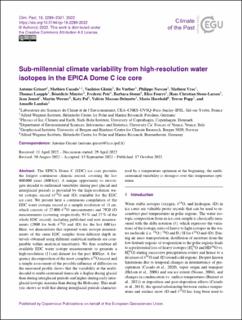| dc.contributor.author | Grisart, Antoine | |
| dc.contributor.author | Casado, Mathieu | |
| dc.contributor.author | Gkinis, Vasileios | |
| dc.contributor.author | Vinther, Bo | |
| dc.contributor.author | Naveau, Philippe | |
| dc.contributor.author | Vrac, Mathieu | |
| dc.contributor.author | Laepple, Thomas | |
| dc.contributor.author | Minster, Bénédicte | |
| dc.contributor.author | Prié, Frederic | |
| dc.contributor.author | Stenni, Barbara | |
| dc.contributor.author | Fourré, Elise | |
| dc.contributor.author | Steen-Larsen, Hans Christian | |
| dc.contributor.author | Jouzel, Jean | |
| dc.contributor.author | Werner, Martin | |
| dc.contributor.author | Pol, Katy | |
| dc.contributor.author | Masson-Delmotte, Valérie | |
| dc.contributor.author | Hoerhold, Maria | |
| dc.contributor.author | Popp, Trevor | |
| dc.contributor.author | Landais, Amaelle | |
| dc.date.accessioned | 2023-03-08T13:30:50Z | |
| dc.date.available | 2023-03-08T13:30:50Z | |
| dc.date.created | 2022-12-06T14:42:47Z | |
| dc.date.issued | 2022 | |
| dc.identifier.issn | 1814-9324 | |
| dc.identifier.uri | https://hdl.handle.net/11250/3057109 | |
| dc.description.abstract | The EPICA Dome C (EDC) ice core provides the longest continuous climatic record, covering the last 800 000 years (800 kyr). A unique opportunity to investigate decadal to millennial variability during past glacial and interglacial periods is provided by the high-resolution water isotopic record (δ18O and δD) available for the EDC ice core. We present here a continuous compilation of the EDC water isotopic record at a sample resolution of 11 cm, which consists of 27 000 δ18O measurements and 7920 δD measurements (covering, respectively, 94 % and 27 % of the whole EDC record), including published and new measurements (2900 for both δ18O and δD) for the last 800 kyr. Here, we demonstrate that repeated water isotope measurements of the same EDC samples from different depth intervals obtained using different analytical methods are comparable within analytical uncertainty. We thus combine all available EDC water isotope measurements to generate a high-resolution (11 cm) dataset for the past 800 kyr. A frequency decomposition of the most complete δ18O record and a simple assessment of the possible influence of diffusion on the measured profile shows that the variability at the multi-decadal to multi-centennial timescale is higher during glacial than during interglacial periods and higher during early interglacial isotopic maxima than during the Holocene. This analysis shows as well that during interglacial periods characterized by a temperature optimum at the beginning, the multi-centennial variability is strongest over this temperature optimum. | en_US |
| dc.language.iso | eng | en_US |
| dc.publisher | Copernicus Publications | en_US |
| dc.rights | Navngivelse 4.0 Internasjonal | * |
| dc.rights.uri | http://creativecommons.org/licenses/by/4.0/deed.no | * |
| dc.title | Sub-millennial climate variability from high-resolution water isotopes in the EPICA Dome C ice core | en_US |
| dc.type | Journal article | en_US |
| dc.type | Peer reviewed | en_US |
| dc.description.version | publishedVersion | en_US |
| dc.rights.holder | Copyright 2022 The Author(s) | en_US |
| cristin.ispublished | true | |
| cristin.fulltext | original | |
| cristin.qualitycode | 1 | |
| dc.identifier.doi | 10.5194/cp-18-2289-2022 | |
| dc.identifier.cristin | 2089523 | |
| dc.source.journal | Climate of the Past | en_US |
| dc.source.pagenumber | 2289-2301 | en_US |
| dc.identifier.citation | Climate of the Past. 2022, 18 (10), 2289-2301. | en_US |
| dc.source.volume | 18 | en_US |
| dc.source.issue | 10 | en_US |

